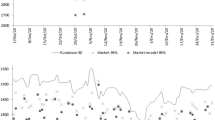Abstract
Through application of state-space modelling, the asset pricing model is re-explored. The result is an asset pricing model which tracks the evolution of investor probability beliefs and learning through a Kalman filter. This behaviourally inspired model shows marked improvement over a traditional asset pricing model, with pricing errors being reduced by as much as 41 % over a 16 year period using South African equities data. We find that investors tend to price long-run risk whilst being notably influenced by exposure to lagged market performance. Together, these findings lend support to the hypothesis that investors tend to price risk as a dynamic learning process in an emerging market.
Similar content being viewed by others
References
Adrian, T., & Franzoni, F. (2009). Learning about beta: Time-varying factor loadings, expected returns, and the conditional CAPM. The Journal of Empirical Finance, 16(4), 537–556.
Artikis, P. G., & Nifora, G. (2011). The industry effect on the relationship between leverage and returns. Eurasian Business Review, 1(2), 125–145.
Barberis, N., & Thaler, R. (2003). A survey of behavioural finance. In G. M. Constantinides, M. Harris, & R. M. Stulz (Eds.), Handbook of the economics of finance (pp. 1053–1128). Amsterdam: North-Holland.
Basiewicz, P. G., & Auret, C. J. (2009). Another look at the cross-section of average returns on the JSE. The Investment Analysts Journal, 69, 23–39.
Basiewicz, P. G., & Auret, C. J. (2010). Feasibility of the Fama and French three factor model in explaining returns on the JSE. The Investment Analysts Journal, 71, 13–25.
Campbell, J. Y., & Vuolteenaho, T. (2004). Bad beta, good beta. The American Economic Review, 94(5), 1249–1275.
Chen, Y., & Lai, K. K. (2013). Examination on the relationship between VHSI, HSI and future realized volatility with Kalman filter. Eurasian Business Review, 3(2), 200–216.
Chen, N.-F., Roll, R., & Ross, S. A. (1986). Economic forces and the stock market. The Journal of Business, 59(3), 383–403.
Chen, N.-F., & Zhang, F. (1998). Risk and return of value stocks. The Journal of Business, 71(4), 501–535.
Clark, T. E. (2004). Can out-of-sample forecasting comparisons help prevent overfitting. The Journal of Forecasting, 23(1), 115–139.
Commandeur, J. J., Koopman, S. J., & Ooms, M. (2011). Statistical software for state space methods. The Journal of Statistical Software, 41(1), 1–18.
Fama, E., & French, K. (1992). The cross section of expected stock returns. Journal of Finance, 47, 427–465.
Fama, E. F., & French, K. R. (1993). Common risk factors in the returns on stocks and bonds. The Journal of Financial Economics, 33(1), 3–56.
Fama, E. F., & French, K. R. (1998). Value vs growth: The international evidence. The Journal of Finance, 53(6), 1975–1999.
Fraser, E., & Page, S. (2000). Value and momentum strategies: Evidence from the Johannesburg stock exchange. The Investments Analysts Journal, 51, 25–35.
Fu, F. (2009). Idiosyncratic risk and the cross-section of expected stock returns. The Journal of Financial Economics, 91, 24–37.
Goetzmann, W. N., & Kumar, A. (2004). Why do individual investors hold under-diversified portfolios? Unpublished working paper, Yale University.
Gupta, R., & Modise, M. P. (2013). Macroeconomic variables and South African stock return predictability. Economic Modelling, 30, 612–622.
Hamilton, J. D. (1994). Chapter 50 state-space models. The Handbook of Econometrics, 4, 3039–3080.
Hommes, C. (2001). Financial markets as nonlinear adaptive evolutionary systems. The Journal of Quantitative Finance, 1(1), 149–167.
Hou, K., & Moskowitz, T. J. (2005). Market frictions, price decay, and the cross-section of expected returns. The Review of Financial Studies, 18, 981–1020.
Huang, P., & Hueng, J. C. (2009). Interest-rate risk factor and stock returns: A time-varying factor-loading model. Applied Financial Economics, 19(22), 1813–1824.
Jegadeesh, N. (1990). Evidence of predictable behavior of security returns. The Journal of Finance, 45, 881–898.
Kruger, R., & van Rensburg, P. (2008). Evaluating and constructing equity benchmarks in the South African Portfolio management context. Investments Analysts Journal, 67, 5–17.
Lewellen, J., & Nagel, S. (2006). The conditional CAPM does not explain asset-pricing anomalies. The Journal of Financial Economics, 82(2), 289–314.
Mindell, D. A. (2000). Cybernetics: Knowledge domains in engineering systems. Research paper, Massachusetts Institute of Technology.
Peeperkorn, J., & Seetharam, Y. (2014). A proposed model to behaviourally pricing risk. Journal of Economic and Behavioral Studies, 6(6), 454–487.
Rapach, D. E., Wohar, M. E., & Rangvid, J. (2005). Macro variables and international stock return predictability. International Journal of Forecasting, 21(1), 137–166.
Sharot, T., Riccardi, A. M., Candace, R. M., & Phelps, E. A. (2007). Neural mechanisms mediating optimism bias. Nature, 450, 102–105.
van Rensburg, P., & Robertson, M. (2003). Style characteristics and the cross-section of JSE returns. The Investments Analysts Journal, 57, 7–15.
Vassalou, M., & Xing, Y. (2004). Default risk in equity returns. The Journal of Finance, 59(2), 831–868.
Welch, G., & Bishop, G. (2004). An introduction to the Kalman filter (pp. 1–16). Chapel Hill: University of North Carolina at Chapel Hill, Department of Computer Science.
Author information
Authors and Affiliations
Corresponding author
Rights and permissions
About this article
Cite this article
Peeperkorn, J., Seetharam, Y. A learning-augmented approach to pricing risk in South Africa. Eurasian Bus Rev 6, 117–139 (2016). https://doi.org/10.1007/s40821-015-0038-9
Received:
Revised:
Accepted:
Published:
Issue Date:
DOI: https://doi.org/10.1007/s40821-015-0038-9




